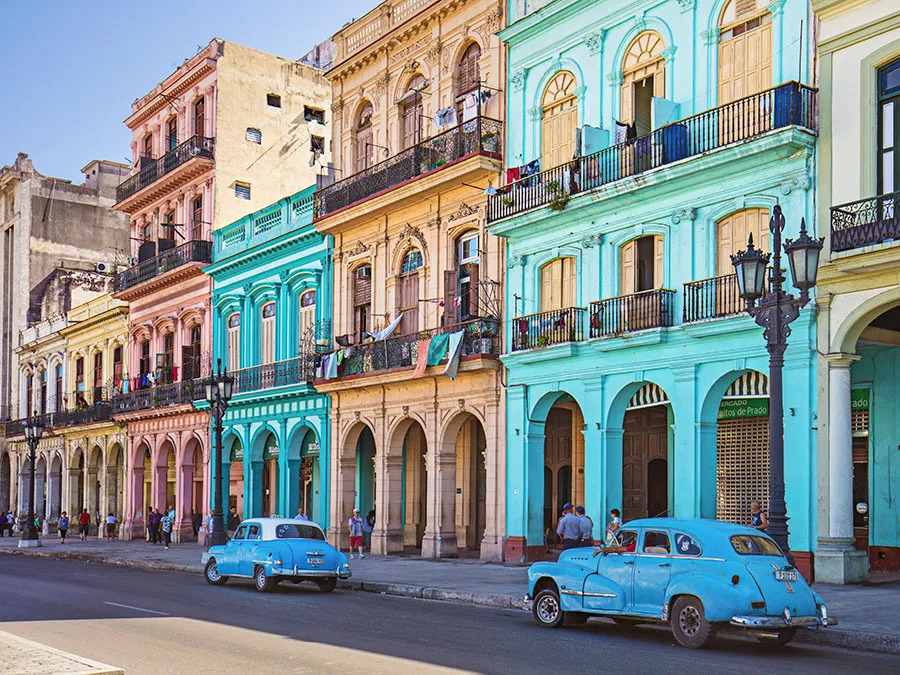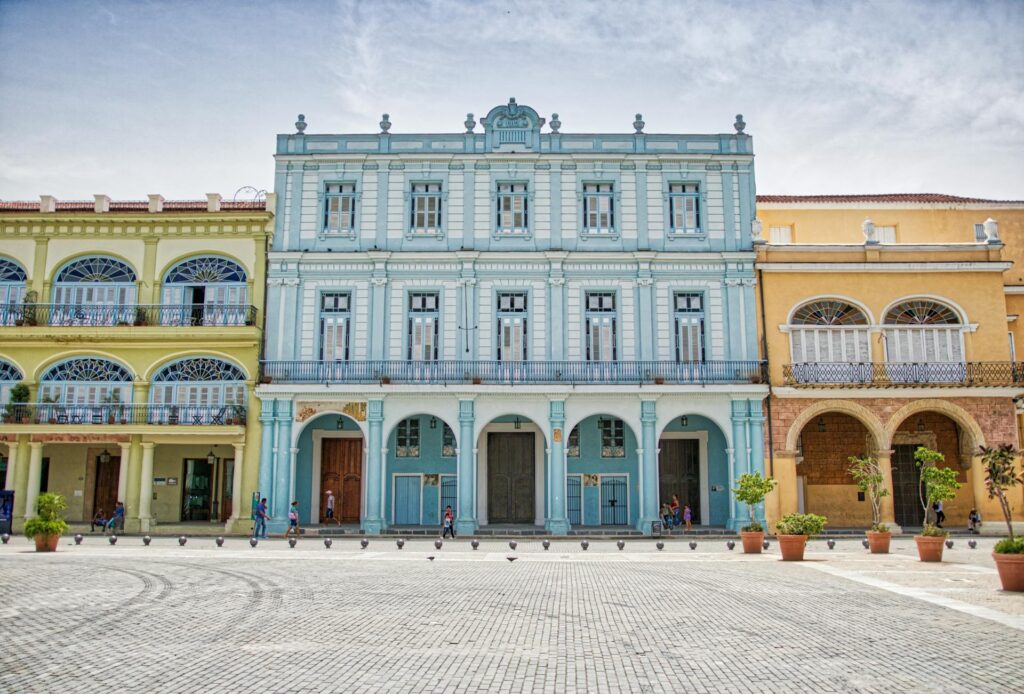Havana, the pulsating heart of Cuba, is a city of contrasts, where the past and present coalesce in an intricate dance of architectural splendor. As you wander through its cobbled streets, you are greeted by a kaleidoscope of styles, from the majestic colonial edifices that whisper tales of history to the vibrant hues of eclectic modernism. The city’s essence is captured in its architecture—a testament to its rich cultural tapestry and tumultuous history. Havana architecture is a gateway to understanding the soul of this enigmatic city, a blend of colonial grandeur and resilient spirit.
The Colonial Foundations
Havana’s architecture is deeply rooted in its colonial past, with buildings dating back to the 16th century when Spanish settlers first arrived. These structures, characterized by their baroque facades and intricate ironwork, were designed to impress and demonstrate power. The grand plazas and the regal mansions lining the streets speak of a time when Havana was a jewel in the Spanish Empire’s crown.
Walking through Old Havana, a UNESCO World Heritage Site, one can still appreciate the meticulous craftsmanship and architectural finesse that define this era. The influence of Moorish architecture is evident in the arched windows and courtyards, reminiscent of the buildings in St. Petersburg and other European cities. This blend of styles is a hallmark of Havana architecture, making it a unique study of cultural amalgamation.
The Influence of Moorish Architecture
The Moorish influence on Havana architecture is undeniable, a legacy of Spain’s own architectural history. This can be seen in the intricate tile work and the use of patios that provide a cool respite from the tropical sun. The blend of Spanish baroque and Moorish styles creates a unique aesthetic that is both exotic and familiar, drawing parallels with the architecture of Paris.
These Moorish elements were not just decorative but functional, providing ventilation and light to the interiors. The use of courtyards allowed for the flow of air, a necessary feature in the humid Cuban climate. This design philosophy echoes the principles seen in the Sheikh Zayed Mosque design, where form and function harmoniously coexist.
The Baroque Splendor
Baroque architecture in Havana is characterized by its ornate details and dramatic expressions. The Cathedral of Havana is a prime example, with its asymmetrical towers and elaborate stonework. This style reflects the opulence and grandeur that the Spanish aristocracy sought to convey, similar to the intricate designs of St. Peter’s Basilica.
The baroque style in Havana is not just limited to religious buildings. The mansions of the wealthy colonists also exhibit this flamboyance, with their grand staircases and lavish gardens. These homes were designed to be seen and admired, a testament to the wealth and power of their owners—a stark contrast to the minimalist trends seen in modern architecture.
The Neoclassical Movement
In the 19th century, neoclassical architecture gained prominence in Havana, influenced by the Enlightenment and a desire for order and symmetry. This style is evident in the grand public buildings, such as the Havana Capitol, which mirrors the grandeur of Las Lajas Sanctuary with its imposing columns and stately facades.
Neoclassical buildings in Havana are marked by their clean lines and balanced proportions, a departure from the ornate baroque style. This shift reflects the changing tastes of the time, as well as the influence of European trends on Cuban architecture. The emphasis on symmetry and harmony is a theme that continues to inspire architects around the world.
The Eclectic Turn
The late 19th and early 20th centuries saw a shift towards eclecticism in Havana architecture, as architects began to experiment with different styles and influences. This period saw the fusion of neoclassical, baroque, and Moorish elements with modernist touches, creating a vibrant and dynamic architectural landscape.
This eclectic approach is evident in the diversity of buildings that line Havana’s streets, from the opulent mansions of Vedado to the art deco gems of El Malecón. This period of experimentation and innovation can be compared to the evolution of architectural styles seen in cities like Paris and Zurich.
The Art Deco Influence
Art Deco left an indelible mark on Havana architecture, with its bold geometric shapes and lavish ornamentation. The Bacardi Building, with its striking tower and colorful facade, is a quintessential example of this style, embodying the optimism and glamour of the 1920s.
Art Deco’s influence extended beyond commercial buildings to residential architecture, with many homes featuring the clean lines and stylized motifs characteristic of the style. This architectural movement mirrored the global fascination with modernity and progress, much like the Sagrada Familia represents a blend of tradition and innovation.
The Impact of Revolution
The Cuban Revolution of 1959 marked a turning point for Havana architecture, as many of the grand colonial buildings were repurposed or fell into disrepair. The revolutionary government prioritized social housing and public buildings, leading to the construction of utilitarian structures that contrasted sharply with the ornate styles of the past.
While some lament the loss of Havana’s architectural heritage, others see it as a testament to the city’s resilience and adaptability. This period of change is reflective of broader trends in modern architecture, where function often takes precedence over form.

The Resilience of Havana Architecture
Despite decades of neglect, Havana architecture has proven remarkably resilient. The city’s buildings bear the scars of time and weather, yet they continue to stand, a testament to the durability and craftsmanship of their builders. This resilience is part of Havana’s charm, a reminder of the city’s storied past and enduring spirit.
Efforts to preserve and restore Havana’s architectural heritage are ongoing, with both local and international organizations working to save these historic structures. This commitment to preservation is crucial for maintaining the city’s unique character and ensuring that future generations can appreciate its crumbling grandeur.
The Role of Restoration
Restoration plays a vital role in preserving Havana architecture, as experts work to repair and stabilize the city’s historic buildings. This process involves not only structural repairs but also the careful restoration of decorative elements, ensuring that the buildings retain their original character.
These efforts are supported by international organizations and governments, recognizing the cultural and historical significance of Havana’s architectural heritage. The restoration of these buildings is a complex and costly endeavor, but one that is essential for preserving the city’s unique identity.
The Tourist Appeal
Havana’s architectural allure draws visitors from around the world, eager to experience its unique blend of styles and history. The city’s vibrant streets and colorful buildings create a picturesque setting that captivates tourists, making it a popular destination for those interested in architecture and history.
The appeal of Havana architecture extends beyond its aesthetics, offering a glimpse into the city’s past and present. For many visitors, exploring Havana’s streets is a journey through time, an opportunity to connect with a bygone era and witness the resilience of a city that has weathered countless storms.
The Cultural Significance
Havana architecture is not just about buildings; it is a reflection of the city’s cultural identity and history. Each structure tells a story, from the colonial past to the revolutionary present, offering insights into the social and political forces that have shaped the city.
This cultural significance is recognized by UNESCO, which has designated Old Havana a World Heritage Site. This designation highlights the importance of preserving Havana’s architectural heritage for future generations, ensuring that the stories of the past are not forgotten.
The Future of Havana Architecture
The future of Havana architecture is uncertain, as the city grapples with the challenges of modernization and preservation. As new developments rise, there is a risk that the city’s historic character could be lost, overshadowed by contemporary designs.
However, there is hope that Havana can strike a balance between progress and preservation, honoring its architectural heritage while embracing the future. This balance is crucial for maintaining the city’s unique identity and ensuring that Havana architecture continues to inspire and captivate.
The Global Context
Havana architecture is not an isolated phenomenon; it is part of a broader global context that includes influences from Europe, the Americas, and beyond. The city’s architectural styles reflect a global exchange of ideas and cultures, much like the Christian architecture seen in churches around the world.
This global context is essential for understanding the full scope of Havana’s architectural heritage, highlighting the interconnectedness of cultures and the enduring impact of historical influences.
The Lessons of Havana
Havana architecture offers valuable lessons for architects and designers around the world. Its resilience and adaptability demonstrate the importance of craftsmanship and the enduring appeal of timeless design. The city’s unique blend of styles serves as a reminder of the power of cultural exchange and the potential for innovation within tradition.
As the world grapples with the challenges of urbanization and climate change, Havana provides a model for sustainable development, emphasizing the importance of preserving cultural heritage while embracing modernity.
Conclusion
Havana’s crumbling grandeur is a testament to the city’s rich history and enduring allure. Its architecture tells a story of resilience, creativity, and cultural fusion, offering a glimpse into the soul of a city that has captivated the world for centuries. As Havana continues to evolve, its architectural heritage remains a vital link to the past, a source of inspiration for the present, and a beacon of hope for the future. Through the preservation and celebration of Havana architecture, we can ensure that this remarkable city continues to enchant and inspire for generations to come.

Recent Posts
15 Floor Plan Graphic Styles That Will Elevate Your Presentation Game
The Role of Shadows in Architectural Storytelling
When Furniture Becomes Architecture: Blurring the Line